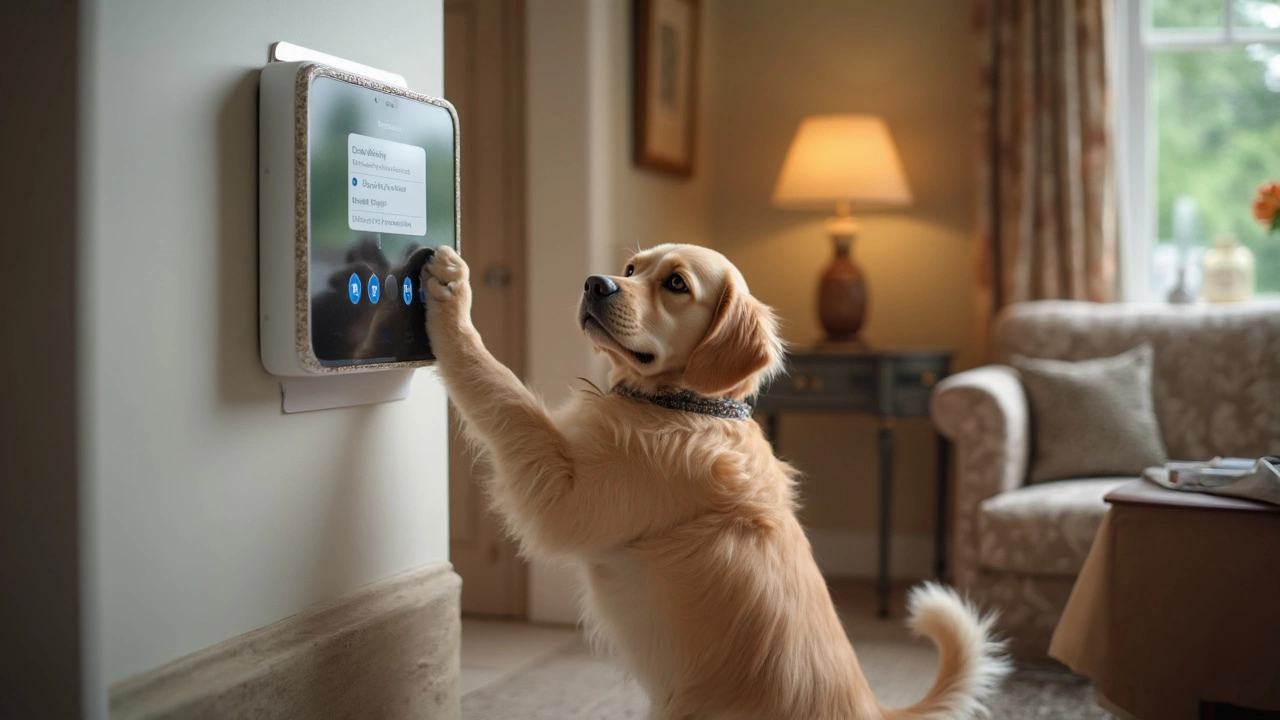Ever feel like your security system is creating more chaos than calm because your pet can't stop triggering false alarms? You're not alone. Many pet owners face this little dilemma—it's like their furry friends have a secret mission to set off every alarm in the house.
So, how can you ensure that your home stays secure without driving yourself (and your pets) up the wall? Enter pet-friendly alarm systems. These are designed to ignore pets while focusing on actual security threats.
First off, it's important to understand how these systems work. Most rely on advanced motion sensors that can differentiate between a person and a smaller animal, usually based on weight and movement patterns. This allows your pet to roam freely without triggering an alarm every time they stroll past a sensor.
But here's the kicker: not all pet-friendly systems are created equal. You'll want to look for options that allow you to adjust the sensitivity settings to match your pet's size and usual antics. This way, whether you've got a pouncing kitten or a laid-back Great Dane, there's a setting that'll work for you.
- Understanding Pet-Friendly Alarms
- Motion Sensors and Your Pets
- Choosing the Right Alert System
- Smart Notifications and Monitoring
Understanding Pet-Friendly Alarms
Alright, let's kick things off by tackling the basics of what pet-friendly alarms are all about. These aren't your run-of-the-mill systems; they're cleverly designed with both security and our furry companions in mind. The secret sauce? It's all about how they handle motion detection. Regular motion sensors go off when pretty much anything moves, while pet-friendly versions make sure your Labrador isn't setting off a siren every time he gets up for a midnight snack.
So, how do they work? Usually, these alarms are calibrated to ignore movements from creatures weighing less than a certain amount, often around 80 pounds. That means most cats and dogs can roam around freely without triggering alarms. The systems do this by using infrared technology or even smart algorithms that can predict whether that movement is from a human or a pet.
Factors to Consider
When hunting for a good pet-friendly alarm, it's crucial to check for a few features.
- Adjustability: Some systems let you fine-tune their sensitivity. This comes in handy if you've got a cat that thinks it's a ninja or a particularly active hamster.
- Pet Immunity Level: Check what weight range the alarm can handle. You need something that matches your pet's size.
- Setup: Does it fit easily into your home style, or will it require a complete overhaul of your decor?
- Integration: Can the alarm system connect with other smart devices for a seamless tech experience?
Now, speaking of modern integration, some companies offer systems where the alarm is coupled with cameras that can recognize pet types and potential intruders, like something out of a futuristic movie. It's all about finding a balance between trusting new tech and knowing it'll do its job respecting your pet's freedom.
| Brand | Pet Weight Limit | Price Range |
|---|---|---|
| SafePet | Up to 85 lbs | $200-$400 |
| GuardGuardian | Up to 75 lbs | $150-$350 |
| PawSecure | Up to 90 lbs | $250-$500 |
So, there you have it. Understanding these details helps ensure that your home stays safe and your pets are stress-free. By knowing what features to look for and doing a bit of research on different brands, you're well on your way to a peaceful, pet-friendly, secure home.
Motion Sensors and Your Pets
Let's take a closer look at motion sensors - a crucial part of any home security system that can quickly become a nuisance when pets are involved. Traditional motion sensors can mistake your pet for an intruder, especially if your dog thinks it's in a race every time it sees a squirrel through the window.
Why Motion Sensors Falsely Trigger
The typical issue here is that standard motion sensors detect any movement, regardless of size or shape. They work by picking up on changes in infrared energy - warmth, basically. So when your pet wanders into the sensor's range, it triggers an alert that can lead to you receiving false alarms, interrupting your day with unnecessary worry.
Go Pet-Friendly
Luckily, there are pet-friendly alarms out there that have your back. These sensors are programmed to ignore movement from animals under a certain weight, often between 40-80 pounds. If your pet is a Newfoundland or another giant breed, you might need systems designed with bigger weights in mind.
Sensor Positioning Matters
An important tip is to position motion sensors strategically. Place them in areas where your pets don't usually roam. Have high-traffic pet zones? Install the sensors at a height that won't catch them in their line of sight, typically around 6-8 feet above the floor.
Adjust Sensitivity Settings
Did you know many sensors allow you to tweak their sensitivity? This lets you customize how easily they detect changes in the environment, greatly reducing false alerts. It's all about finding that sweet spot where your security system is effective, but not overzealous.
Remember, the goal is to protect your home while not worrying every time your cat decides to go for a midnight stroll across the living room. Balancing security with your pet's comfort is all part of creating a cozy, safe home for everyone.
| Pet Type | Recommended Sensor Weight Limit |
|---|---|
| Small Dogs/Cats | Up to 40 lbs |
| Medium Dogs | Up to 60 lbs |
| Large Dogs | Up to 80 lbs |

Choosing the Right Alert System
Picking the right security system when you have pets is more about understanding their habits and quirks than simply buying the first pet-friendly option you find. It’s not one-size-fits-all since every pet and every home is different.
Start by considering your pet’s size and behavior. A system that works for a 10-pound cat might not be suitable for a 70-pound dog. Many modern house alarms come with adjustable motion sensors. These can be set to ignore motion below a certain weight limit, often ranging from 50 to 80 pounds.
Know Your Sensor Options
There are several sensor types to consider:
- Passive Infrared (PIR) Sensors: These detect body heat, perfect for filtering out small animals.
- Microwave Sensors: They cover larger ranges but are pricier and might be too sensitive if your pet loves jumping onto furniture.
- Dual-Tech Sensors: Combining PIR with microwave, they offer balanced reliability but can be fatty in combination with certain meddlesome pets.
Think About Integration and Smart Features
In today’s tech-driven world, many alarm systems integrate with other smart home devices. Opt for systems that let your alarms communicate with each other. This not only adds a layer of security but also eases the automation of notifications for various activities, giving you peace of mind.
Another great feature is the ability to monitor and control your alarm system through a smartphone app. Look for systems that allow you to get alerts, switch alarm modes, and even adjust motion detection settings remotely. This ensures you stay in control, no matter where you are.
If you're one for stats, check this out. A survey in 2024 found that 45% of pet owners who use integrated systems reported fewer false alarms, adding a practical reason to consider tech-savvy options.
Professional Installation vs. DIY
Finally, decide between a professionally installed system or a DIY kit. Professional setups tend to be more expensive but offer expert calibration to prevent false alarms caused by your pets. On the other hand, DIY systems can save money and are often easy to install, but make sure to thoroughly read through instructions to customize it for your pet-friendly home.
Remember, whether you're protecting your home with or without pets, the key is to find a balance that suits both security needs and your pet’s comfort.
Smart Notifications and Monitoring
Let's talk about how smart notifications can totally transform your security system experience, especially when you have pets. Gone are the days where you're stuck wondering if your home is secure while you're out. Thanks to modern tech, you can get real-time alerts directly to your phone.
Imagine this: you're at work and you get a notification that there's been movement in your living room. Rather than panicking, you can pull up your security camera feed and see that it's just your cat practicing parkour around the furniture. This kind of instant feedback is essential for any pet owner using a pet-friendly alarm system.
Customization is Key
Most smart security systems out there today let you customize how and when you receive alerts. This is a game-changer. You can usually tailor notifications to ignore certain times, rooms, or specific motion levels. Got an active dog who loves his afternoon zoomies? Maybe you want to deactivate alerts in the backyard during playtime hours. Giving yourself this flexibility leaves you sane and keeps your phone from blowing up unnecessarily.
Real-Time Monitoring with Phone Apps
Another amazing feature is real-time camera monitoring. Many systems, including big names like Ring and Nest, offer integrated apps that let you peek inside your home from anywhere you have an internet connection. This peace of mind is priceless, especially when you're on vacation or at work.
To illustrate, here's a simple breakdown of notifications vs. time with pet-friendly systems:
| Time | Pet Movement | Notification Received |
|---|---|---|
| Morning (9 AM) | Dog walks around the house | No |
| Afternoon (1 PM) | Cat jumps on window sill | No |
| Evening (6 PM) | Unknown movement near backdoor | Yes |
The important thing here is setting your preferences right. A little upfront work to identify your pet’s habits can save a ton of hassle later.
Investing in a security system that values customization and real-time alerts is beneficial for both your home’s safety and your peace of mind. These pet-friendly alarms keep you updated without stressing you or your pets out.

